Risk exposure and loss
Quantitative Risk Management in Python

Jamsheed Shorish
Computational Economist
A vacation analogy
Hotel reservations for vacation
Pay in advance, before stay
- Low room rate
- Non-refundable: cancellation fee = 100% of room rate
Pay after arrival
- High room rate
- Partially refundable: cancellation fee of 20% of room rate

Deciding between options
- What determines your decision?
- Chance of negative shock: illness, travel disruption, weather
- Probability of loss
- Loss associated with shock: amount or conditional amount
- e.g. VaR, CVaR
- Desire to avoid shock: personal feeling
- Risk tolerance
- Chance of negative shock: illness, travel disruption, weather


Risk exposure and VaR
- Risk exposure: probability of loss x loss measure
- Loss measure: e.g. VaR
- 10% chance of canceling vacation: P(Illness) = 0.10
- Non-refundable:
- Total non-refundable hotel cost: € 500
- VaR at 90% confidence level: € 500
- Partially refundable:
- Refundable hotel cost: € 550
- VaR at 90% confidence level: 20% cancellation fee x € 550 = € 110
Calculating risk exposure
- Non-refundable exposure ("$\text{nr}$"):
- P(illness) x $\text{VaR}_{0.90}^{\text{nr}}$ = 0.10 x € 500 = € 50.
- Partially refundable exposure ("$\text{pr}$"):
- P(illness) x $\text{VaR}_{0.90}^{\text{pr}}$ = 0.10 x € 110 = € 11.
- Difference in risk exposure: € 50 - € 11 = € 39.
- Total price difference between offers: € 550 - € 500 = € 50.
- Risk tolerance: is paying € 50 more worth avoiding € 39 of additional exposure?
Risk tolerance and risk appetite
- Risk-neutral: only expected values matter
- € 39 < € 50 $\Rightarrow$ prefer non-refundable option
- Risk-averse: uncertainty itself carries a cost
- € 39 < € 50 $\Rightarrow$ prefer partially refundable option
- Enterprise/institutional risk management: preferences as risk appetite
- Individual investors: preferences as risk tolerance
Loss distribution - discrete
- Risk exposure depends upon loss distribution (probability of loss)
- Vacation example: 2 outcomes from random risk factor
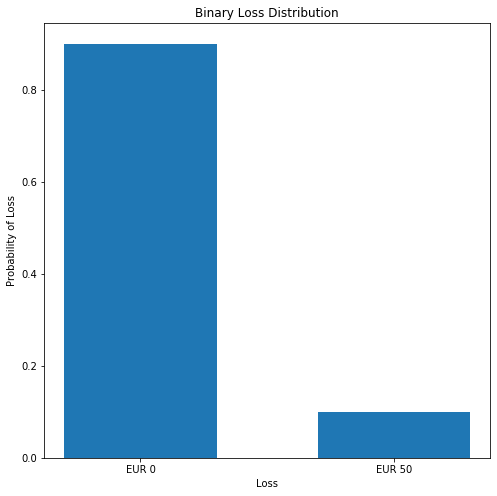
Loss distribution - continuous
- Risk exposure depends upon loss distribution (probability of loss)
- Vacation example: 2 outcomes from random risk factor
- More generally: continuous loss distribution
- Normal distribution: good for large samples
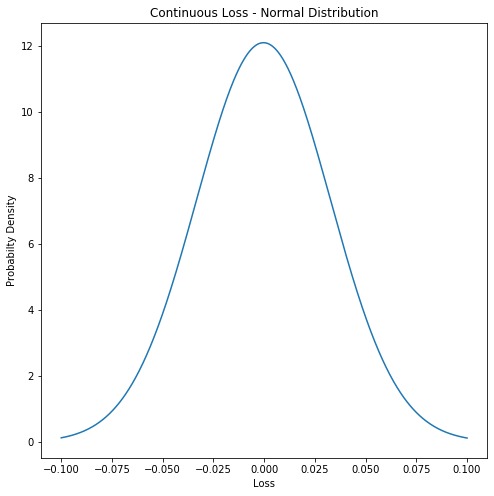
Loss distribution - continuous
- Risk exposure depends upon loss distribution (probability of loss)
- Vacation example: 2 outcomes from random risk factor
- More generally: continuous loss distribution
- Normal distribution: good for large samples
- Student's t-distribution: good for smaller samples
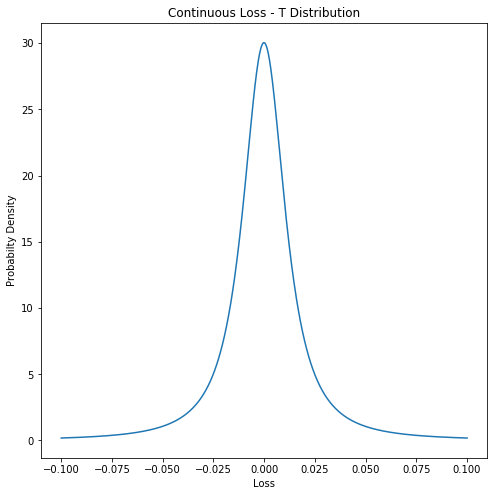
Primer: Student's t-distribution
- Also referred to as T distribution
- Has "fatter" tails than Normal for small samples
- Similar to portfolio returns/losses
- As sample size grows, T converges to Normal distribution

T distribution in Python
- Example: compute 95% VaR from T distribution
- Import
tdistribution fromscipy.stats - Fit
portfolio_lossdata usingt.fit()
- Import
from scipy.stats import tparams = t.fit(portfolio_losses)

T distribution in Python
- Example: compute 95% VaR from T distribution
- Import
tdistribution fromscipy.stats - Fit
portfolio_lossdata usingt.fit() - Compute percent point function with
.ppf()to find VaR
- Import
from scipy.stats import tparams = t.fit(portfolio_losses)VaR_95 = t.ppf(0.95, *params)
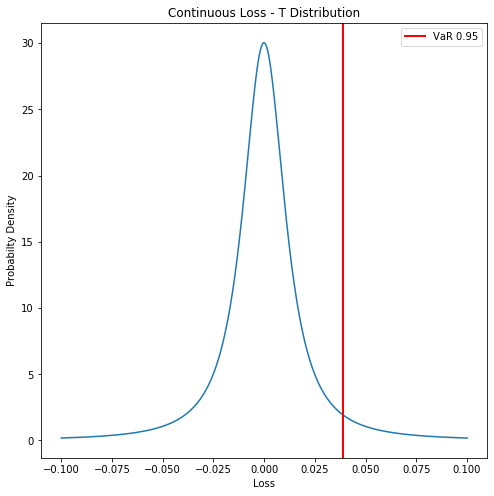
Degrees of freedom
- Degrees of freedom (df): number of independent observations
- Small df: "fat tailed" T distribution
- Large df: Normal distribution
x = np.linspace(-3, 3, 100)plt.plot(x, t.pdf(x, df = 2))plt.plot(x, t.pdf(x, df = 5))plt.plot(x, t.pdf(x, df = 30))
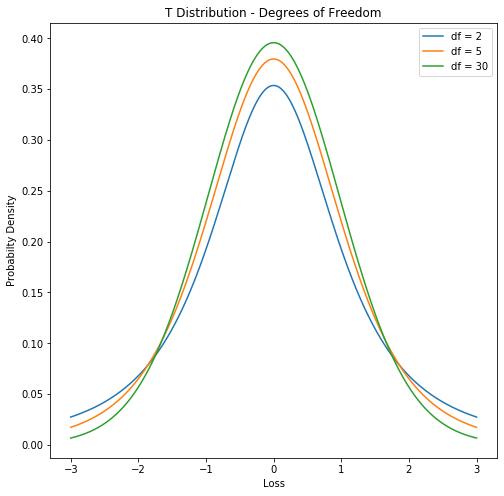
Let's practice!
Quantitative Risk Management in Python

